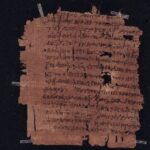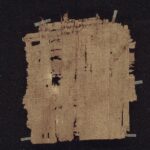| Artefact ID | 980 |
| TM ID | TM 59668 |
| Findspot (DEChriM ID) | - () | Class | Textual |
| Material | Papyrus |
| Writing medium | Codex |
| Text content | Literary |
| Language | Greek |
| Description | P.Iand. V 69; P.Giss.Lit. 5.2; KV18 Papyrus fragment from a folio containing a theological text on the divinity of Christ: possibly an unknown work by Didymus Caecus. The fragment measures 10 x 9 cm, and preserves 16 lines of text on the recto (written in one column) as well as parts of 4 lines on the verso. The left margin measures approx. 2 cm, and the bottom margin 1 cm. On the verso, there is a diple which indicates that this could be the final folio of a theological work, and the text contains elements of the accession of Christ to the heavens. The ed. pr. associated the text with Psalm 67 (certainly quoted in l. 14), and suggests that the work is connected to Origen or Didymus, as is also suggested by G. Krüger; see the ed. pr. The allegorical approach within the text is reminiscent of Didymus Caecus, as is also pointed out in the red. ed. It has also been suggested that the work could be a homily on Ps 67 authored by a student of the Alexandrian school, such as Didymus, Origen or one of their pupils; see Ausenda 1940: 46. The text contains quotes from inter alia Ps 67:34 andCol 1:18 and 1:20. The hand is described as a "business cursive" of the early Byzantine type; see ref. ed. The text contains several nomina sacra, and occasional other abbreviations (of i. a. καί and εἰσί). There is one aspiration (above ὡς in l. 4) and one diaeresis (over the iota in ἵνα in l. 5). |
| Selection criteria | Literary genre (Theological), Nomina sacra, Biblical quote or paraphrase |
| Date from | 300 |
| Date to | 399 |
| Dating criteria | Palaeography. The ed. pr. places the fragment in the 4th c. based on the parallel with P.Lond. III 1244 (private letter from the 4th c.; provenance N/A). |
| Absolute/relative date | Relative date |
| Archaeological context | The provenance is uncertain: a possibility would be the Arsinoites in the Fayûm, as the fragment was purchased in Madînet al-Fayûm in 1926; see ref. ed. |
| Accession number | Giessen, Universitätsbibliothek P. Iand. 272 |


 Json data
Json data





